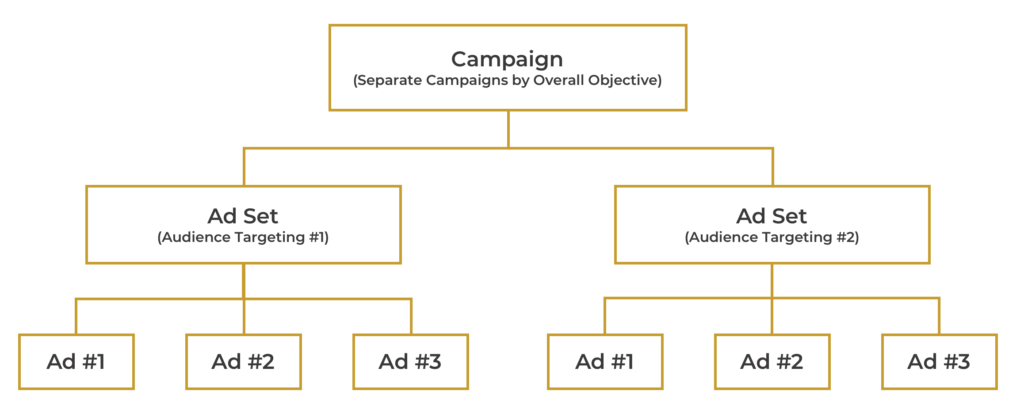This article offers a quick look at one way to structure your account for collecting leads.
Basic Structure
A fundamental step in adding Facebook Ads to your digital toolset for lead generation is understanding campaign structure in your business page’s ad account.
Facebook’s advertising back end is comprised of a three level approach:
- Campaigns
- Ad Sets
- Ads
The easiest way to visualize the structure is a tree with Campaigns at the top. Campaigns can hold multiple Ad Sets and each Ad Set can hold multiple Ads.

Let’s briefly explore each level in regards to the most basic Lead Generation objective.
Campaigns
First, you’ll want to create a new Campaign using the Lead Generation objective. This objective allows you to create Ad Sets within your campaign that are optimized for gathering leads without the prospect ever having to leave Facebook. By harvesting the prospect’s information within Facebook, the friction of the process is greatly reduced which can lead to higher conversion rates.

When running ads for both jStaab & Co. and for our clients, we’ll typically break campaigns down into New Customer Acquisition (NCA) and Retargeting (RTG). NCA campaigns are for cold prospecting and RTG campaigns are for people who are already familiar with your business from interacting with your page, website, or a previous ad. RTG ads typically have a higher Return on Ad Spend (ROAS) because the audience has been warmed up for a sale.
Ad Sets
The Ad Set is where you’ll select our target audience, set your ad duration, set daily or lifetime budgets, and automate or manually select ad placement options.
There are multiple ways to target Facebook users, but the most basic is through interest based audiences. Check out our post on creating an Ideal Customer Profile (ICP) to dial in the best target audience for your ads based on demographics, psychographics, and behavioral trends. Once you have defined your ICP it’s easy to input the information into Facebook to find people that best fit your ideal parameters.
As you continue to become more familiar with audience setup, you’ll find that custom audiences created via your website’s Facebook Pixel or a list of existing or prospective client’s emails can be much more powerful for targeting than interest based audiences. The RTG campaigns mentioned above are made possible once you are able to establish these types of custom audiences.
Ads
Ads are the final step in the tree and are what your potential customer will see. This is where you combine your sales copy and images to create an offer or hook that converts cold traffic to leads.
You can choose a photo, video, or multiple photos and videos for your lead ad. Once the potential client chooses to sign up for your offer they will be shown a contact form directly in Facebook.
Below is a list of fields that you can add to the form to collect data from prospects.

Get Started
Hopefully this high level overview has been helpful with planning the strategy breakdown for your agency’s Facebook ad account. We’ll continue to cover more of the process in-depth with future posts. In the meantime, please leave us a comment if you have questions on the process!

